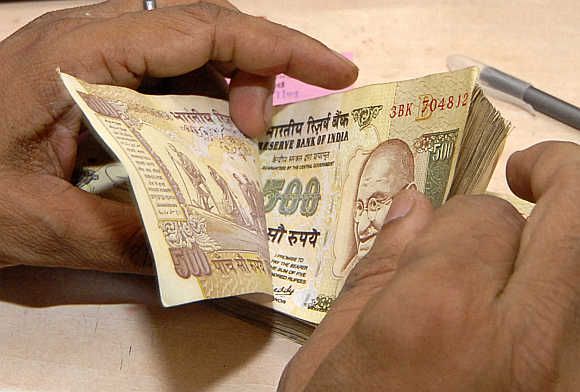As the new regime takes stock after six months, achchhe din (good days) still appear some distance away, notes Devanghsu Datta.

There have been definite improvements in several key economic indicators.
But the latest macroeconomic data send mixed signals.
The Index of Industrial Production (IIP) for September showed year-on-year (y-o-y) gains of 2.5 per cent over September 2013.
The August IIP was revised up to 0.5 per cent from an initial estimate of 0.4 per cent. Those numbers aren't cause for rejoicing,
But the IIP has been in positive territory for several months. On the other hand, total indirect tax collections for April-October 2014 are up by a nominal 5.6 per cent and Central Excise collections were down by 1.2 per cent.
Service tax collections have risen by 11 per cent and customs collections are up about seven per cent.

It's difficult to see how fiscal year targets of 20-per cent tax collection growth will be met. If one adjusts for inflation, the tax collection growth would be close to zero.
The government has taken a reasonable political gamble by raising excise duty on petrol and diesel.
Given the soft trend in international crude prices, this shouldn't hurt consumers much. Lower crude and vegetable prices both contributed to lower inflation.
The y-o-y change in the Consumer Price Index (CPI) suggests retail inflation will continue to trend down.
Core CPI remains stable but fuel and food are dropping. Overall, CPI dropped to 5.52 per cent in October versus 6.46 per cent in September.
It was reinforced by a five-year low in the October Wholesale Price Index, which rose only 1.77 per cent y-o-y.
There is pressure on the Reserve Bank of India (RBI) to cut rates at its review on December 2. But the central bank may maintain the status quo given base effects.
Inflation was very high in July-December 2013. The bond market sent interesting signals.

The 10-year Treasury yield are at 8.17 per cent, lower than the one year T-yield of 8.35 per cent.
The Indian bond market is inefficient and data woefully lacking.
But yield inversion may mean a rate cut is expected and, of course, it may also mean that investors are anticipating recessive conditions.
The latter is unlikely and the rate-cut bulls could be disappointed in December at least.
Banks have seen a huge rally with speculators gambling on rate cuts.
The Bank Nifty has the highest sector-weight in the Sensex and Nifty and it has been the big driver of broader index gains, along with the non-banking financial companies.
If there is no rate cut in December, a sell-off across the financial sector from over-stretched bulls could trigger correction across the broader market.
The State Bank of India (SBI) has managed to control bad debts.
Gross non-performing assets (NPAs) came down marginally during the July-September quarter.
However, the SBI chairperson estimated that it could take another 12 months for credit offtake to really pick up and, given SBI's reach, her judgement has to be respected.
Incidentally, SBI may be an aberration.
The gross NPAs of 40-listed banks have grown by 17.5 per cent in July-September 2014 compared to July- September 2013.
Gross NPAs in July- September 2014 are also up by seven per cent compared with April-June 2014.
On the external front, the dollar's strength is being buttressed by reasonable economic data from America.

The US October payroll data is interpreted as positive and US GDP is estimated to have grown at an annualised 3.5 per cent in July-September 2014.
Meanwhile, European inflation is in line with expectations and Japan continues its monetary expansion with the yen down to a seven-year-low.
GDP estimates for China have been pared slightly but the market has discounted this with softer commodity prices.
There is increasing tension in Ukraine with uniformed Russian troops and tanks operating in eastern Ukraine.
The rouble has seen a near-catastrophic decline of over 30 per cent and this could trigger depreciation across other former Soviet nations.
The combination of sanctions, and low fuel prices is really hurting the Putin regime.
Amid all this, Indian equity continues to rise to new record heights with the foreign institutional investors (FIIs) pumping in large sums ever since the Bank of Japan announced its expansionary policy.
At the domestic level, the RBI's next policy review could be the next news-based trigger for either trend reinforcement or reversal.











